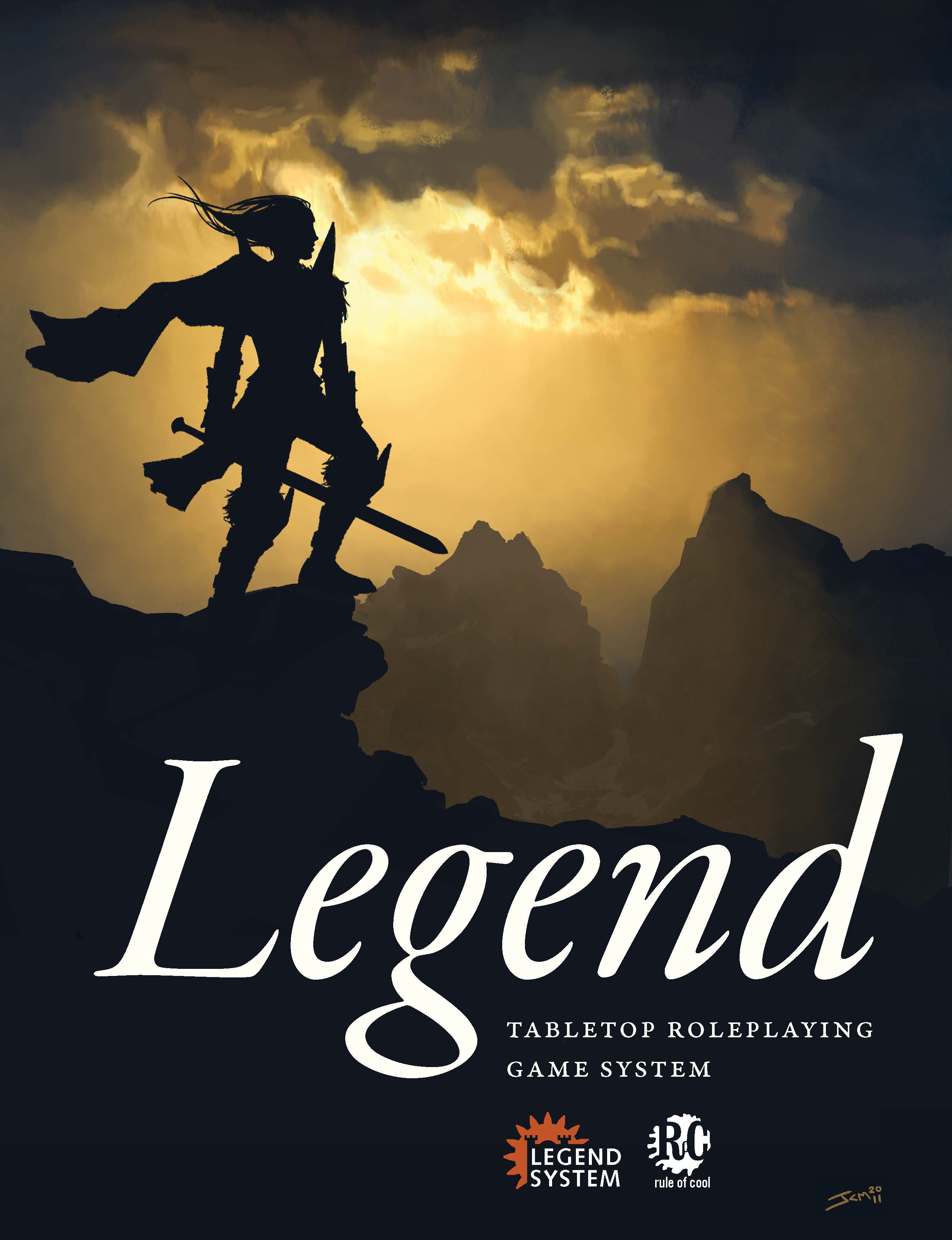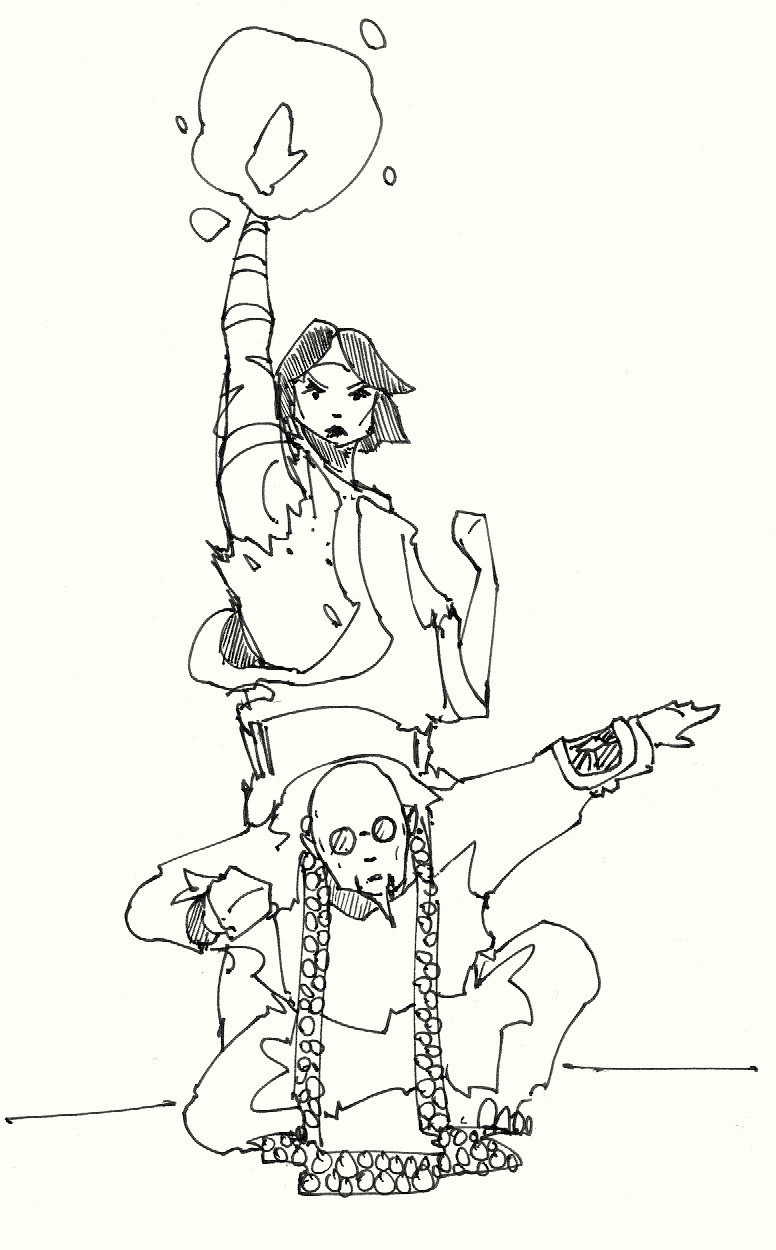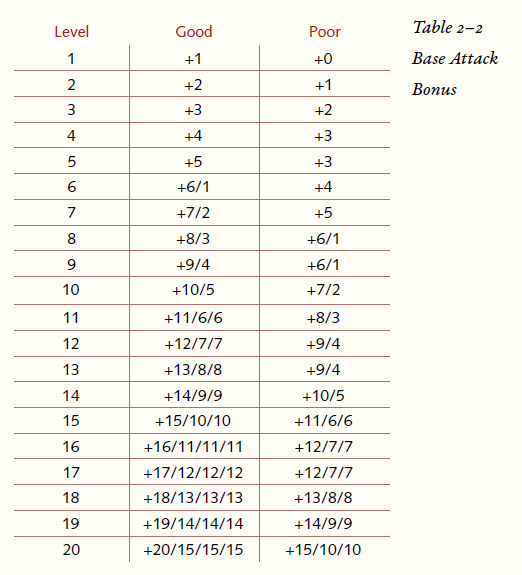Legend d20 by Covok
Does anyone ever read the introduction?
Original SA post Tell Me A Legend Of Murderers And Hobos - Let's Read Legend D20
While the game goes the mechanically complex route, the cover certainly does sweet and simple well.
So, what is Legend? It's a roleplaying game made by a group of 3.5 fans who didn't feel like 4e was for them, but didn't like the class disparity in 3.5. Unlike the bunch of other game developers who tried to make a balanced 3.5, Legend isn't another 3.75. While it isn't the most original game and doesn't accomplish everything it sets out to do, it's still a fun title that keeps its own identity.
I actually beta tested this game back in 2012 so, since they finally released the finished version, I thought I'd do a read through of it.
Chapter 1: Does anyone ever read the introduction?
Legend's introduction chapter is actually a bit different from the norm. While it does have the standard "what is roleplaying" section, it does take some interesting directions.
For one, its the only place in the book where the default setting is ever described or even mentioned. You'd think something like that might get more page space than just one paragraph.
Basically, there is a world called Hallow.
Fantasy creatures live on Hallow.
It is geographically diverse place.
There are powerful magical constructs.
The end.
To be fair, there is a pdf on their website that expands on hallow and its history. But, that isn't in the rulebook, so most players wouldn't know anything about it.
The lack of setting information is probably why the writers push for custom setting and refluffing. Pushing the GM to make custom settings and refluff mechanics is perfectly fine, but...
quote:
Of course, if your gaming group has a different world in mind, feel free to play in it instead. Legend’s mechanics can fit a broad range of fantasy and horror settings, and with some minor adjustments can fit superhero, cyberpunk, and even space opera settings. For all of these settings, and others, Legend offers you the tools to tell the story your specific gaming group wants to create.
...the developers kind of overestimate their system's flexibility. It's really a game that best supports pulpy fantasy games. At low levels, you maybe able to do gritty fantasy, but not too well. At high levels, you're pretty much playing Exalted. Trying to run horror in this title would be...interesting. And, by interesting, I mean it probably wouldn't work at all.

Legend's art is usually pretty good. This one piece, not so much.
Legend's developers then decided to spend some times directly stating what they like in roleplaying games and then give a blanket statement on how Legend incorporates it. So, why don't we take a look through? Maybe refer back to these design principals periodically to see if the developers succeeded or not.
Predictability - It's kind of a shaky start since it begins on a verisimilitude argument. Though, it's not a bad one. Kill a wolf, get a wolf pelt. Kill a swordsman, find a sword. Live in a magic world your entire life, you should probably be able to tell when stuff is magical.
As Above, As Below - Legend sells itself on a few key selling points and one of them is being balanced. If two characters are the same level, they should be equally good in different ways. Does Legend manage to pull this off? Well, I suppose we'll find out.
Narrative Space - Legend's developers like generic systems that can support multiple genres. Game math, in their opinion, should be open so player's can alter it as needed. It's a bit funny that they call out other games, indirectly, for not being honest about what types of genres their games can support considering the Legend developers believe Legend game can run horror.
GM/Player Cooperation - The standard "everyone is responsible for each's other fun" argument that appears in almost every modern game book. Not that I don't agree with the idea, it's just become a bit of a cliche.
Speed of Play - For some, this design goal could be a bit of a deal breaker. They love eight hour gaming sessions and think combat should go for several rounds. Unless I'm misinterpreting, they like the idea of getting five combat encounters done in that 8 hour session. I don't know if they were accounting for down time or not, but it does say alot about the speed of combat.
In short, encounters lasting over an hour was something the developers actively strived for. Does combat actually turn out taking that long? In the beta, battles almost always took about thirty to forty minutes with some going longer. Way longer.
And that's the end of Chapter 1. Since this took a bit longer than expected, I'll end here for now.
Next Time: We get into the basics of gameplay, see how Legend changes some of 3.5's math, and then move into the basics of character creation.
That Basics
Original SA post
You know, funny story, I was talking to Amercha about how our Legend's playtest went. And, wow, did we mess it up. Apparently, the GM house ruled the hell out of the game. Which is, I probably don't have to say, horrible for playtesting. Apparently, Amercha only found this out when he submitted his playtesting feedback. So, yeah, we kind of screwed up that playtest.
Anyway, without further ado, let's return to...
Tell Me A Legend of Murderers and Hobos
Chapter 2: That Basics
The chapter starts out going over the standard d20 fair. The core mechanic is what you expect (1d20 + modifiers), you can take 10 and 20 using the standard rules, and a blurb on attributes and modifiers.
An interesting thing is that the game brings up percentile dice which is funny since we never had to use those during our entire playtest. Then again, as said prior, the GM houseruled the hell out of that game so, now, I don't know if any of my assumptions on this title are true.
Modifers are typed, thankfully. Modifiers from the same type or from the same source do not stack (take the best bonus or worst penalty). Of course, this is still standard d20 affair and the types are what you expect (Ability, Circumstance, Feat, Item, Racial, Size, and Untyped).
The only different ones are Deflection and Fury. Deflection is a boost to AC. Fury, on the other hand, is interesting as it is the first time tracks are mentioned. This will be further explained as we reach the class chapter. For now, just know that Fury bonuses come from strong emotions, are given by tracks, stack with Fury bonuses from the same track, but not with Fury bonuses from different tracks.
After this, we get into Ability scores. Unsurprisingly, the game uses the standard d20 6 (Str, Con, Dex, Wis, Int, Cha). However, there is a twist: Key Offensive Modifier and Key Defensive Modifier. KOM and KDM come from a player's class (sometimes from a particular Track or Race).
KOM is used to calculate a character's ability to attack and adds to damage rolls for weapon damage.
KDM is used to calculate HP and Armor Class.
Key modifiers is an interesting idea. I mean, it simplifies character building since you know to put your highest value in those two attributes and have a functional character. On the other hand, it can sometimes make one feel like they only have two attributes. Though, I suppose the Skill system, which we will get to later, does make use of the other attributes even if most of your character doesn't.
After KOM and KDM, Spellcasting Ability modifier is introduced. When one takes a spellcasting track -- tracks have still not been explained -- they receive a SAM from that track. This modifier is used for DCs for their spells and determines if the character gets more spells than the default.
In this same section, we learn Legend uses a variant of D&D's vancian magic. Instead of per day, Legend's magic is done per scene. It is worth noting that the game does not mention what a Scene is. It also appears that spells only go up 7 levels...err circles. This, in my opinion, is for the best. 9 levels of spells is too much. That said, 5 is a better number of levels than 7. Or circles. Or whatever.
The book then explains what each attribute represents. Most of this is fairly standard from 3.5, however, Constitution gives Damage Reduction equal to half one's Con mod (if positive) instead of adding to one's HP and Wisdom adds to something called the Awareness Defense.
The reason I sound a bit confused by the latter is because our DM never used this so I don't actually know what this is. After looking over Legend's character sheet, I noticed there were a few other defenses (Diplomacy,Bluff, Intimidate, and Perception). While we haven't got an official explanation for them yet, I believe they are a DC that opponents have to pass when trying to use skills on a character. Our DM used opposed rolls. Somehow, I feel this is just another house rule he made...Should I make a counter for the number of ways we messed up playtesting this game?
Afterwards, we get into d20's standard secondary statistics: Health points, Armor Class, Base Attack Bonus, and Saving Throws. Interestingly enough, Awareness is brought up here and confirms my suspicion that it was a defense for skill rolls against player characters (in this case, it is a DC one has to pass to successfully sneak past a character). Another interesting thing is that BAB is added to one's AC which I don't remember being a factor in 3.5. It also appears saving Throws take the higher of two attributes modifiers: Str/Con for Fort, Dex/Int for Ref, or Wis/Cha for Will.
Most of the formulas for secondary statistics has also been changed. Armor Class is now 10 + BAB + KDM, Health is now Class (Which classes offer either 8,10, or 12 per level) + KDM then that sum is multiplied by twice one's level, and Attack is 10 + BAB + KOM.
The most interesting thing about this section is that Legend changed how the math for BABs worked.

As you can see, while the first additional attack goes up at a different rate, the next three additional attacks go up at the same rate as the first additional attack. Poor BAB's received a boost and another additional attack. 3.5 had each additional attack go up at a slower rate for a max of 20/15/10/5 on a good BAB and 10/5 for a poor BAB. Poor BABs in 3.5 only received a single additional attack.
This seems a bit odd. I do remember this game having a bigger focus on track abilities (which we will get to later) and basic attacking than using spells. As such, boosting poor BABS might be necessary. Then, because you boosted poor BABs, you might have to boost good BABs just to make sure they're still good in comparison...I guess. I have to seem more math of the system to see if this works out. Considering BAB is also added to AC, I really have to wonder if this math works out as intended.
Well, that is it for Chapter 2. None of this really has confirmed or denied if the Legend Developers lived up to their design goals. I will say that the lack of explanation for the other defenses is a bit off. Sure, they are on the character sheet and one can easily guess their use by name (Diplomacy, Bluff, Intimidate, Perception), but they should be mentioned. Or, I should say, they should be mentioned in the same chapter as awareness.
I know I said I'd get into character creation, but its a bit late so I'm going to save that for later.
As such...
Next Time: Character Creation or Yes, you can play a Dragon Barbarian Power Ranger